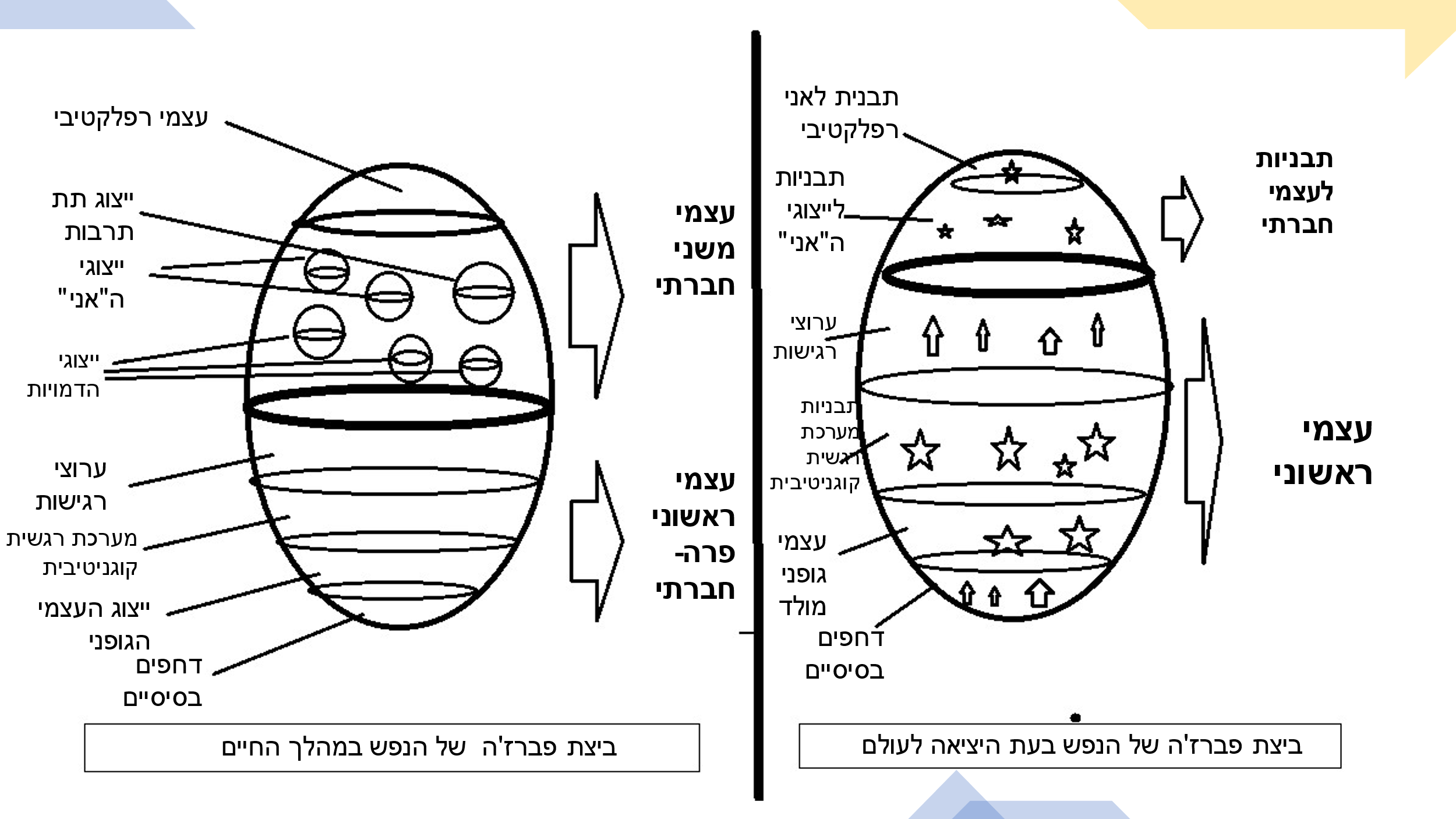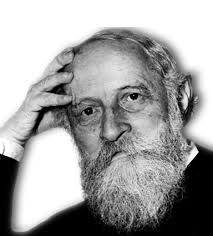Conversation 15: Understanding the relationship "I and Thou" according to Buber within the framework of the theory of internalized characters
Hi,
We have already written that "because man is a world in its entirety" – there is nothing like this sentence to emphasize the connection between the environment in which man lives and his inner world. From the moment a person is born until his death, he is subject to environmental influence. Like a sponge, he absorbs the characters of the significant people in his life. These characters can be called "reference group or groups". These actually shape us, our attitudes, our emotional world and ultimately – our behavior as well. These groups may influence us directly, with the greater social influence the more important the influencing group seems to be, and in a more complex way that cannot be immediately identified. The important reference groups undergo a process of internalization and become an inseparable part of the person and operate within him even when the original groups no longer exist. Some of these effects exist without permeating the person's consciousness, turning him in a certain sense into a kind of a "robot" that performs a job not his own, according to the "software program" determined by other people who have now become his internalized characters and become part of his inner world. The many conflicts that occur between these internal characters, between them and their own selves and between the contemporary reference groups in the person's external reality may cause a person to go from mental crises to the level of actual mental disorders. We note that most mental disorders begin or worsen following stressful situations. It turned out that a significant part of these situations occurs against the background of the external [in the outside world] and internalized social groups to which the person belongs.
In the model we propose for the "self", one must first differentiate between the primary self, which is actually the basic biological nucleus consisting of a number of innate structures as shown in figure number 1 and which is subject to development during life. and the [secondary] social self, which is a structure that develops during a person's exposure to social influence, and consists of internalizations of figures significant to the person, originating either from external groups or from imaginary groups related, for example, to a character from a story, from a myth, from a movie, etc. that had a considerable influence on the person). We note here that at birth [see Figure 1] there are innate patterns for most parts of the self such as for example the "social self" and its parts that form nuclei for a possible future development of these structures.
The physical self is defined as the set of experiences related to the perception of the body, its limits and sensations, that also includes thoughts, attitudes and feelings towards the body, and which begins with the innate physical self which, as mentioned, continues to develop in a process of human life.
The "secondary selves" include: 1] the variety of representations of the "I" that originate from attitudes and feelings towards the self and its representations in different periods of life. 2] the representations of internalized characters that often originate from significant characters that the person is exposed to during his life but as mentioned there may also be imaginary characters represented in books, movies, etc. ' that had a considerable influence on man.
3] representations of the "subculture" [subculture refers to social influences in the milieu [environment] in which the person lives and are not necessarily related to a specific person].
And finally we will mention the "Reflective Self" or the "Reflective Me", which is defined as a structure that develops following the development of the social self and enables a comprehensive perspective of the individual's state of awareness and mental expressions.

This time we will discuss the understanding of the "I and Thou" relationship according to the philosopher Martin Buber within the framework of the theory of internalized characters.
I and Thou is a philosophical essay by Martin Buber that presents a social-philosophical concept that deals with dialogic relationships between people, which are based on honest and direct relationships. Buber attaches crucial importance to interpersonal speech in his claim that the subject will be shaped within the dialogue and the relationship with the other. It is this discourse with the other that builds man as having a spiritual consciousness and personality. According to Buber, the relationship "I-Thou is found in a mental connection to the other in contrast to "I-Them" where the other is used as a tool to achieve a goal without a deep mental connection to him. The dialogue in the form of I – Thou, is an act of intimacy of love and responsibility for the other and is different from objective responses that strive for a goal in everyday life. According to Buber, the essence of the creation of a person as a person is expressed in his words: "A person is made of “I in Thou" “I” has no existence without “Thou” present in front of it. Buber writes: "The meeting of man with himself is possible and necessary only as the meeting of the person with his fellow man … only when the individual person recognizes the other in all his otherness as a self, as a person, and from this recognition he emerges and goes towards him, he breaks the barrier of his loneliness….It is clear that this cannot happen but from the vibrations of the personality…" [See Wikipedia].

Martin Buber [1878 – 1965 ]
It is interesting that Buber applied these relationships to non-human objects, for example to a tree or to a work of art, and this is how he expresses himself regarding these two:
Regarding the tree:
"Here I look at the tree.
I can look at it like a picture: a frozen pillar, surrounded by a river, splashing a green and blue grace on the silver sky.
I can experience it as a movement: extending to the stem and aspiring to the top.
I can feel the suction of the roots, the breath of the leaves, the constant contact and burden with the earth, with the air – and even feel the growth itself in the latency of the darkness.
I can associate the tree with its species and type and observe it as a single fact, wonder about its structure and lifestyles.
To the extent that I can completely disregard its uniqueness and beauty, and see in the tree an expression of the general law of nature only – an example of the laws according to which materials mix or separate. I can compress the tree into a number, into a pure relationship between data and numbers.
In all of these the tree is not but an object against me [my relationship to this]. its place and its time, its type and situation.
However, it may also happen, when desire and kindness come together, that when I look at the tree I will suddenly find that I have a relationship with it – and it will no longer be a mere thing [the relationship between I and Thou].
And regarding the creation of art:
Here I look at the artwork.
I can look at it like a picture: a frozen thing, surrounded by a river, splashing graceful humility on a silver background.
I can experience it as a movement: moving in space and aspiring to heaven.
I can feel the suction of the creative material, its breath, its contact and its ceaseless burden with the earth, the building with the air –
And even feel its own breath in the darkness.
I can associate the work with its species and type and observe it as a single fact, wonder about its structure throughout its life.
To the extent that I can completely disregard its uniqueness and beauty and see the work as an expression of the general law of human nature only – an example of the laws according to which materials mix or separate. I can translate into a number, into a pure relationship between data and numbers.
In all of these there is no creation but an object against me [my relationship with myself]. A place for her and a time for her, a type for him and a situation.
However, it may also happen, when desire and grace come together, that upon looking at the work of art I will suddenly find that it involves a relationship – and it will no longer be just a thing [the relationship between me and you].
Buber's unique approach strengthens the claim of the theory of internalized characters that man is a social creature and his essence as a man develops in relation to others. The question arises as to what happens in the board of internalized characters when the relationship between I and Thou takes place [we assume here that such relationships, although rare, are possible and are not an ideal that we can approach but cannot be fully realized]. First we will discuss the rare occurrence of such relationships with a complete stranger. Imagine a train ride that lasts hours through desolate prairies and an intimacy develops for her, a heart-to-heart conversation in which a relationship of love, intimacy and responsibility towards a complete stranger takes place. First, it seems that here in the "me and you" relationship, the dominant character or characters in the board of introverted characters allows and removes censorship associated with the attachment to this character who is increasingly introverted apparently in a rapid and relatively more complete manner relative to other characters with their feelings, thoughts and attitudes.
If, on the other hand, an I-and-you relationship exists with a familiar character who has previously been internalized into the board of introverted characters, then following the closeness of the I-and-you relationship, the introverted character becomes more complete with her feelings, thoughts, and attitudes, and it is possible and her dominance increases, although this is not necessary. It is possible that another new version of her will be created that will become more topical and represented compared to the previous character.
It is interesting that Buber extended the possibility of creating I and Thou relations to other forms of life from humans and even to objects. Is Buber creating a personification in this reference since we don't see how it is possible to create an honest and complete I and Thou relationship with another person without speaking, without dialogue, and isn't this a characteristic of human beings and in his conversation with the tree, for example, does he not allow the tree or the work of art to "speak to him" back?
If, on the other hand, an I-and-Thou relationship exists with a familiar character who has previously been internalized into the board of internalized characters, then following the closeness of the I-and-Thou relationship, the internalized character becomes more complete with its feelings, thoughts, and attitudes, and it is possible that its dominance increases, although this is not necessary. It is possible that another new version of it will be created that will become more actual and representative compared to the previous character.
It is interesting that Buber extended the possibility of creating I and Thou relations to other forms of life from humans and even to objects. Is Buber creating a personification in this reference since we don't see how it is possible to create an honest and complete I and Thou relationship with another person without speaking, without dialogue, and isn't this a characteristic of human beings and in his conversation with the tree, for example, does he not allow the tree or the work of art to "speak to him" back?
In this context, we will mention that within the board of internalized images there is a place for internalized imaginary characters and perhaps there is also a place for life forms and objects that undergo significant personification and are internalized as significant characters in the board of characters?
So much for this conversation
Yours until the next time
Dr. Igor Salganik and Prof. Joseph Levine
 Prof. Joseph Levine, M.D. is an emeritus associate professor in the Division of Psychiatry, Faculty of Health Sciences, Ben Gurion University in Israel. Prof. Levine is a certified psychiatrist with clinical experience in controlled trials of adult psychiatric disorders and in psychotherapy. He was awarded a NRSAD independent investigator grant for the study of Creatine Monohydrate in psychiatric disorders -- mainly Schizophrenia. He resides and treats patients in Tel Aviv and all of central Israel.
Prof. Joseph Levine, M.D. is an emeritus associate professor in the Division of Psychiatry, Faculty of Health Sciences, Ben Gurion University in Israel. Prof. Levine is a certified psychiatrist with clinical experience in controlled trials of adult psychiatric disorders and in psychotherapy. He was awarded a NRSAD independent investigator grant for the study of Creatine Monohydrate in psychiatric disorders -- mainly Schizophrenia. He resides and treats patients in Tel Aviv and all of central Israel.
Leave a comment